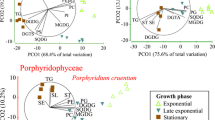Summary
Ten obligate marine fungi have as their principal fatty acids 16∶0, 18∶0, 18∶1n9 and 18∶2n6. The fatty acids ranged from 14 to 22 carbons, completely dominated by those with even numbers of carbons. The amount of unsaturated fatty acids varied between 35% and 80%. Each isolate contained small amounts of the acids 18∶3n3 and 20∶4n6. Branched, hydroxy- or cyclic fatty acids were not detected. Multivariate statistical, i.e. principal component analysis, showed that all ten strains could be distinguished on the basis of their fatty acid composition. These results indicate that the marine fungi do not have an unusual fatty acid composition and suggest that chemometric, multivariate analysis might be employed to confirm taxonomic relationships among these organisms.
Similar content being viewed by others
References
Ackman, R.G. 1989. Fatty acids. In: Marine Biogenic Lipids, Fats and Oils (Ackman, R.G., ed.), Vol. 1, pp. 104–137, CRC Press, Boca Raton, FL.
Bajpai, P.K., P. Bajpai and O.P. Ward. 1992. Optimisation of culture conditions for production of eicosapentaenoic acid byMortierella elongata NRRL 5513. J. Indust. Microbiol. 9: 11–18.
Block, J.H., P. Catafalmo, G.H. Constantine, Jr and P.W. Kirk, Jr. 1973. Triglyceride fatty acids of selected higher marine fungi. Mycologia 65: 488–491.
Cooney, J.J. and C.M. Proby. 1971. Fatty acid composition ofCladosporium resinae grown on glucose and on hydrocarbons. J. Bacteriol. 108: 777–781.
Gandhi, S.R. and J.D. Weete. 1991. Production of the polyunsaturated fatty acids arachidonic and eicosapentaenoic acid by the fungusPythium ultimum. J. Gen. Microbiol. 137: 1825–1830.
Jones, E.B.G. and P.J. Byrne. 1976. Physiology of the higher marine fungi. In: Recent Advances in Aquatic Mycology (Jones, E.B.G., ed.), pp. 135–175, Elek Science, London.
Jones, E.B.G. and G. Rees. 1984. Observations on the attachment of spores of marine fungi. Bot. Mar. 27: 145–160.
Kendrick, A.J. and C. Ratledge. 1992. Microbial polyunsaturated fatty acids of potential commercial interest. SIM Indust. Microbiol. News 42: 59–65.
Kirk, P.W., Jr. 1969. Isolation and culture of lignicolous marine fungi. Mycologia 61: 174–177.
Kirk, P.W., Jr. 1980. The mycostatic effect of seawater on spores of terrestrial and marine higher fungi. Bot. Mar. 23: 233–238.
Kirk, P.W., Jr. 1983. Direct enumeration of marine arenicolous fungi. Mycologia 75: 670–682.
Kirk, P.W. and A.S. Gordon. 1988. Hydrocarbon degradation by filamentous marine higher fungi. Mycologia 80: 776–782.
Kirk, P.W., B.J. Dyer and J. Noe. 1991. Hydrocarbon utilization by higher marine fungi from diverse habitats and localities. Mycologia 83: 227–230.
Kock, J.L.F. 1988. Chemotaxonomy and yeasts. S. African J. Science 84: 735–740.
Kohlmeyer, J. and E. Kohlmeyer. 1979. Marine Mycology, the Higher Fungi. Academic Press, New York, 690 pp.
Kohlmeyer, J. and B. Volkmann-Kohlmeyer. 1991. Illustrated key to the filamentous higher marine fungi. Bot. Mar. 34: 1–61.
Kvalheim, O.M. and T.V. Karstung. 1987. A general-purpose program for multivariate data analysis. Chemometrics Intell. Lab. System. 2: 235–237.
Lechevalier, H. and M.P. Lechevalier. 1988. Chemotaxonomic use of lipids — an overview. In: Microbial Lipids (Ratledge, C. and S. G. Wilkinson, eds), Vol. 1, pp. 869–902, Academic Press, New York.
Losel, D.M. 1988. Fungal lipids. In: Microbial Lipids (Ratledge, C. and S.G. Wilkinson, eds), Vol. 1, pp. 699–806, Academic Press, New York.
Miller, J.D. and N.J. Whitney. 1981. Fungi of the Bay of Fundy. III. Geofungi in the marine environment. Mar. Biol. 65: 61–68.
Ratledge, C. 1986. Lipids. In: Biotechnology, (Pape, H. and H.-J. Rehm, eds), Vol. 4, VCH Publishers, Deerfield Beach, FL.
Rees, G. 1980. Factors affecting the sedimentation rate of marine fungal spores. Bot. Mar. 23: 375–383.
Weete, J.D., M.S. Fuller, M.Q. Huang and S. Gandhi. 1989. Exper. Mycol. 13: 183–195.
Wold, S. and M. Sjostrom. 1977. SIMCA: a method for analyzing chemical data in terms of similarity and analogy. Amer. Chem. Soc. Symp. Series 52: 243–282.
Wold, S., C. Albano, W. Dunn et al. 1984. Multivariate data analysis in chemistry. In: Chemometrics: Mathematics and Statistics in Chemistry (Kowalski, B.R., ed.), pp. 17–95. Reidel, Dordrecht.
Author information
Authors and Affiliations
Rights and permissions
About this article
Cite this article
Cooney, J.J., Doolittle, M.M., Grahl-Nielsen, O. et al. Comparison of fatty acids of marine fungi using multivariate statistical analysis. Journal of Industrial Microbiology 12, 373–378 (1993). https://doi.org/10.1007/BF01569668
Received:
Revised:
Accepted:
Issue Date:
DOI: https://doi.org/10.1007/BF01569668




